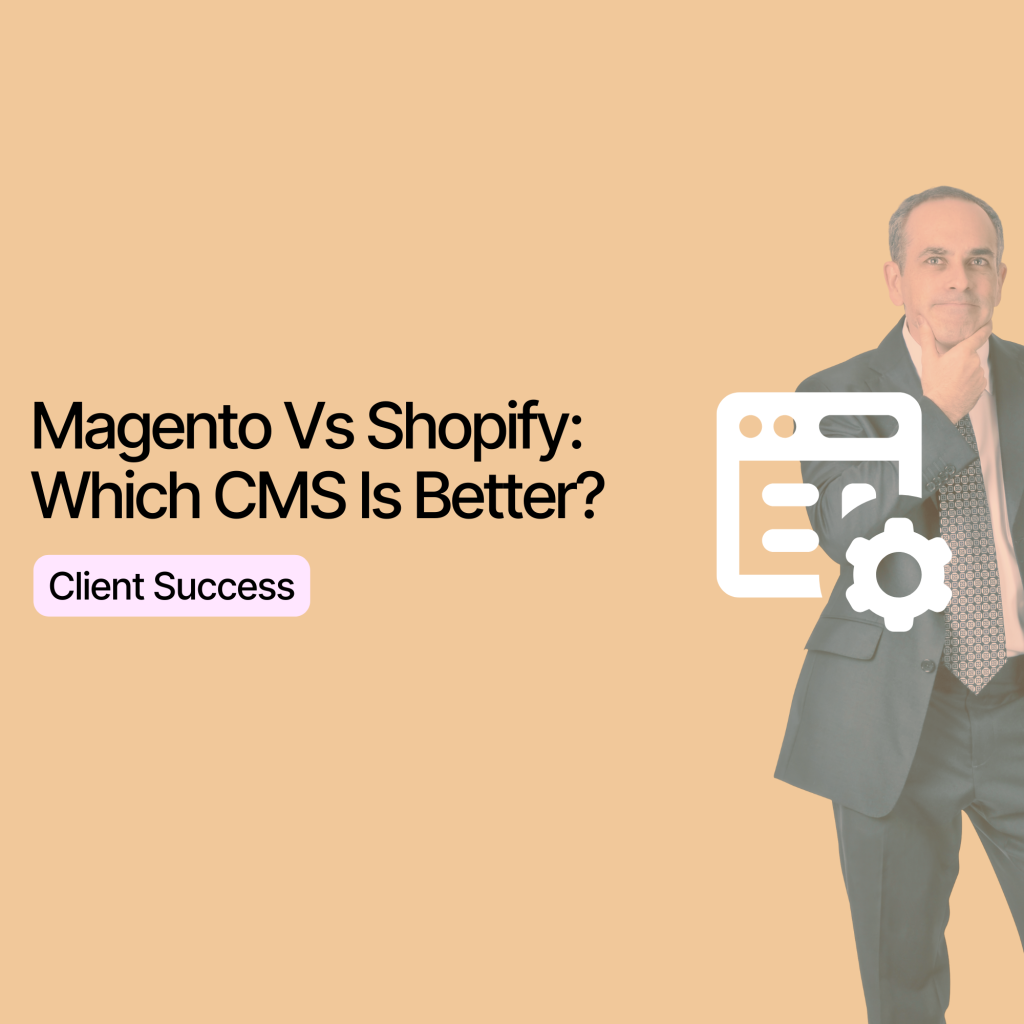Are you starting a new business or considering migrating from your current CMS platform to a new one that will suit your eCommerce business needs, but you aren’t sure which one is best? In this guide, we’ll compare some of the most popular CMS platforms – Magento vs Shopify – to help you determine which one best aligns with your business needs.
Whether you’re a small start-up looking for simplicity and cost-effectiveness or a large business in need of full customisation and scalability, let’s explore which CMS can help you elevate your eCommerce store.
What Is Magento?
Magento is a popular CMS platform that allows businesses to build and manage their online store. By being built on open-source technology, developers can design a custom website that is unique to your business.
Its powerful marketing tools, ability to manage large catalogues, and fully customisable design make Magento the go-to choice, particularly for medium to large businesses.
What Is Shopify?
Shopify is a popular eCommerce platform designed to help you create and manage your online inventory. Shopify supports multiple payment gateways, including its own Shopify Payments, allowing merchants to accept credit card payments and integrate with third-party processors like PayPal and Stripe.
Overall, Shopify is a fantastic CMS platform for smaller or start-up businesses due to its user-friendly interface and ability to create a professional-looking, low-cost eCommerce website.
What You Need to Consider When Choosing A CMS Platform for Your eCommerce Store?
When it comes to choosing which CMS platform is better for your eCommerce store, you need to consider elements like how the CMS aligns with your business strategies, the predicted growth of your business and your budget.
For example, if you want a professional, bespoke website that could easily scale with your growing product range, Magento would be the ideal solution. However, as Magento is very technical and difficult to navigate, you’d need to invest in a Magento developer to ensure your eCommerce website is set up correctly.
Now that you have a better understanding of the overarching elements that you need to consider when choosing a CMS platform, let’s take a look at the features of Magento vs Shopify, crowning the overall best in class for each section.
Ease Of Use
Magento Ease Of Use
Magento has many complex and detailed features and requires a significant amount of technical knowledge to set up and maintain.
Shopify Ease Of Use
Shopify has a user-friendly interface that lets you set up and maintain a professional-looking store, making it ideal for small to medium-sized businesses.
Ease Of Use Winner
Shopify – In regards to ease of use, Shopify takes the crown. However,with the help of our team of specialists, we can help you navigate the obstacles that you might come across with Magento.
Customisation
Magento Customisation
Magento has a range of 4,000+ themes and extensions to allow full customisation of your eCommerce website. With the help of a website developer, you can create a bespoke website that caters to online stores of various sizes and requirements.
Ready-made Magento themes can cost an average of £100, with custom themes costing anywhere from £600-£25,000.
Shopify Customisation
Shopify has 200+ fully customisable themes to help improve your customers user experience, store functionality and sales. Depending on the type of web-design that you’re going for, Shopify themes can cost £140-£180 each.
Customisation Winner
Magento – Although Shopify offers budget-friendly themes overall, Magento takes the crown due to the level of depth and complexity available. However, without the help of a developer, Shopify might be a preferred option for a budget-friendly option.
Product Management & Scalability
Magento Product Management & Scalability
Magento is fantastic when it comes to handling large product catalogues in particular. It allows for detailed customisation and categorisation, ensuring that you can easily update and optimise your product listings to enhance your customers shopping experience.
Magento’s advanced inventory management features help maintain accurate stock levels and streamline your customers’ ordering process. Its ability to integrate with various third-party services and extensions further enhances its functionality, allowing your business to scale efficiently and respond to market demands.
Shopify Product Management & Scalability
Shopify provides excellent performance and can handle high traffic volumes. However, Shopify’s scalability can be limited by the platform’s inherent restrictions compared to Magento’s open-source environment.
Product Management & Scalability Winner
Magento – Although both platforms can handle busy eCommerce stores, Magento’s product management capabilities take the crown. Overall, Magento’s product management platform contributes to an increased operational efficiency, better customer satisfaction and higher sales conversions.
SEO & Marketing Tools
SEO & Marketing Tools Magento
Magento offers various SEO features that allow you to optimise your website’s SEO.
To update SEO fields on products or categories, navigate to Catalogue – select the respective page type and navigate to the Search Engine Optimisation section. For pages, click Content – Pages and select the relevant page to edit. You will then see the Search Engine Optimisation section for you to update the relevant fields.
As previously mentioned, Magento also allows you to download various extensions like Amasty, which allows you to optimise blog pages, FAQs and more.
SEO & Marketing Tools Shopify
Shopify has limited built-in SEO features that allows you to optimise some on-page features like page titles, image alt tags and meta descriptions.
To update SEO fields on your Shopify pages, navigate to Online Store – Pages. In the Search engine listing preview section, click Edit website SEO and update the relevant fields.
If you want to optimise your website’s SEO features to the level that Magento provides as standard within its platform, you’ll need to spend some time in Shopify’s app store to find the perfect SEO app for your business.
SEO & Marketing Tools Winner
Magento – Magento takes the crown due to its SEO features being easily accessible within the platform. If you’d like help with navigating Magento’s SEO features, drop us a line.
Note: Some features require help from a Magento developer. If you’re considering using Magento based on their marketing tools, it’s important to remember that you’ll need to factor in the cost of specialised Magento developers.
Sales Features
Magento Sales Features
Magento offers a range of advanced sales features designed to meet the needs of large-scale eCommerce businesses. It supports complex product catalogues, multiple stores and languages and provides powerful tools for managing promotions and pricing rules.
Magento also offers advanced B2B features, such as customer segmentation, customised pricing and bulk ordering.
Shopify Sales Features
Shopify comes with eCommerce tools built-in as standard to increase conversion rate with little to no additional configuration needed. It includes essential tools such as abandoned cart recovery, discount codes and multi-channel selling. Shopify’s point-of-sale system is integrated seamlessly, allowing for easy in-store and online sales management.
While not as extensive as Magento’s, Shopify’s sales features are more than sufficient for most small to medium-sized businesses.
Sales Features Winner
Magento – Its advanced sales features make it the preferred choice for larger businesses. However, Shopify is ideal for small to medium sized businesses.
Pricing
Magento Pricing
Magento has 2 packages – Adobe Commerce Pro and Managed Services, both costing different amounts.
For Adobe Commerce Pro, pricing typically starts around £30,000 annually, which includes cloud hosting and additional features like advanced security and support. Managed Services offers more customised support and maintenance, but is significantly more expensive. Managed Services ranges from £50,000 to £100,000 per year depending on the specific requirements and scale of your business.
Magento’s pricing can increase based on factors like transaction volume and catalogue size, so we recommend contacting Adobe for a tailored quote.
Shopify Pricing
Shopify operates on a monthly subscription model with varying levels. The most basic plan starts at £19 per month, the next level is £49 per month, and the best Shopify package costs £259 per month.
There are also additional costs for transaction fees. With the basic plan, there’s a flat fee of 2% for all transactions, while the more expensive package will reduce this to 0.6%.
Pricing Winner
Shopify – Although Shopify charges transaction fees, it is considerably more affordable for small or start-up businesses.
Magento vs Shopify - Which CMS Is Better For My Business?
Choosing between Magento vs Shopify depends on your business’s specific needs and resources. Below, we have summarised the key points and winner for each criterion to help you make an informed decision about which CMS might be best for your eCommerce store.
Feature | Magento | Shopify |
Ease Of Use | Very complex interface that can be difficult to navigate. | Overall best in class – User-friendly interface. |
Customisation | Overall best in class – Complex and detailed themes are available. | Budget-friendly themes. |
Product Management & Scalability | Overall best in class – Advanced inventory management to handle and categorise products. | Provides excellent performance and can handle high traffic volumes. |
SEO & Marketing Tools | Overall best in class – Built-in detailed SEO features are available. | SEO apps are available to install (not built-in as standard). |
Sales Features | Overall best in class – Offers advanced sales features – ideal for large businesses. | Offers built-in eCommerce features – ideal for small to medium-sized businesses. |
Pricing | Costly for small or start-up businesses. | Overall best in class – A more cost-effective option for small businesses. |
For small to medium-sized businesses looking for an easy-to-use, cost-effective solution, Shopify is the clear winner. However, for large enterprises with complex requirements, Magento’s customisation and scalability make it a better choice.
Ready to take your eCommerce marketing to the next level?
Ultimately, Magento and Shopify each have their own unique features that make one a better fit than the other, it all depends on your business objectives and budget. If you’re considering changing your CMS platform, or you just want more information, drop us a line. Our team of specialists are on hand to help you get the most out of your eCommerce marketing.
About the author
Joe Turner
Share this post
Read more

